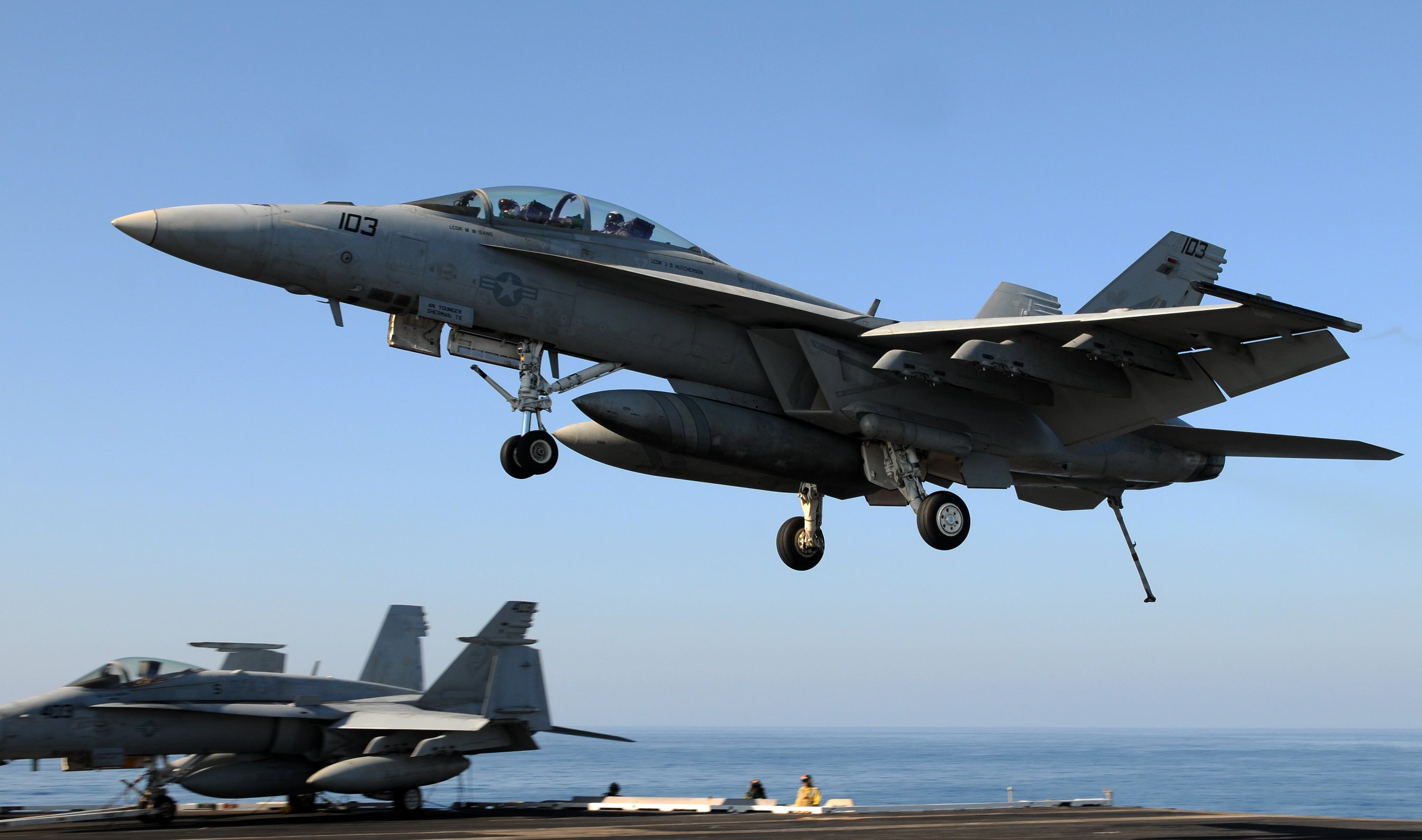Joint strike fighter delays may force the carrier Navy to fly F/A-18 Super Hornets even longer into coming decades, a predicament that could reduce training hours and strain airframes. aviation is in a race against time and resources.
Plans have been in the works to retire the F/A-18C Hornets in the mid-2020s, followed by the F/A-18E and F Super Hornets in around 2035, but the consistently delayed development of the F-35 Lightning II joint strike fighter has compelledforced the serviceNavy to push the Hornets past their planned service lives. The dilemma raises the possibility that Super Hornets still new to the fleet a few years ago may still be flying in three decades. — forcing millions in repairs to extend them — and therefore possibly pushing back the Super Hornets' sundown, as well.
"We might even fly these airplanes close to 2040," air warfare director Rear Adm. Mike Manazir told members of the House Armed Services subcommittee on seapower on TuesdayMonday.
The longest and most expensive acquisition program in Defense Department history is on track for now, but for the Navy, it’s not coming online fast enough to replace the fleet's aging F/A-18 strike fighters, which fleet that have spent more than a decade as carrier-launched warhorses in current conflicts.
"As I think about the continuity of strike fighter inventory management, I have to consider the idea that — just like the F/A-18C, which we had planned to sundown at 6,000 hours and now we're extending to 10,000 hours — that appl[ies]y to the Super Hornet," Manazir told Navy Times in a Friday phone interview.
In the short-term, that means fewerless training hours for pilots and aircrew as the service shifts more airframes into overhauls. In the mid-term, it means a possible gap of 138 aircraft in the early 2020s, Manazir said.
The latest plan now is to take the Super Hornets offline as the Navy's next-generation strike fighter, a program dubbed F/A-XX, comes online. But scheduling that transition is a mix of flight hour estimates and proposed acquisition timelines, which can balloon, as they have with the Hornet/JSFF-35 situation the Navy is dealing with now.
"The sundown idea is a moving target," he said.
The Navy is working to extend the F/A-18Cs to 10,000 hours, and Manazir's office is in the early planning stages of a similar extension for the F/A-18E/F Super Hornets, from 6,000 to 9,000 hours.
To get to that 2035 milestone, he said, the Navy has to get F/A-18Cs to 10,000 hours, F/A-18E/Fs to 9,000 hours, procure enough F-35s for one squadron in each air wing and get F/A-XX to initial operating capability. And that's only if estimates of average yearly flying hours and procurement timelines hold steady.
The Navy has often been billedaccused asof being lukewarm on the F-35C, but part of that has to do with a current capability shortcoming: The aircraft's latestcurrent software suits the Air Force and Marine Corps, Manazir said, but the Navy is waiting for a 2018 update that has a certain mix of the weapons and air wing integration support.
"Because I integrate all my capabilities, I do not need an earlier F-35C with what they call Block-2B software, because it doesn't give me the capability I need in my air wing," he said. "So I'm not going to spend money on those earlier block models. I'm going to wait and buy the Block-3F software."
When the F-35C reaches IOC in 2018, Manazir said, there will be 10 aircraft ready to deploy.
Decades later when the service By the time the Navy is ready to shut down the Super Hornets, he added, the air wing's strike fighter capabilities will be a mix of F-35s, F/A-XX and likely, a second-generation unmanned carrier jet, a progression from what's now being developed in the Unmanned Carrier Launched Airborne Strike and Surveillance program.
Strike fighter gap
Despite careful calculations of flight hours and acquisition plans, as it stands now the fleet could see a shortfall of Navy will be looking at a shortfall about 138 strike fighters in the early 2020s — double the limit to meet readiness guidelines — which could rob air wings of airframes.
"It's a complex formula of keeping ourt current inventory flying, getting them out of the [life extension] depots, buying enough Super Hornets to replace what we've been using every year in the wars in Iraq, Syria and Afghanistan, previously, and then buying capability through JSF," Manazir said.
The Navy has plans to increase speed-up Hornet — and eventually Super Hornet — life extensions; coupled with a proposed buy of 24 to 36 new Super Hornets over the next three years, Manazir said, a shortfall could be mitigated.
"Those Super Hornets have the most effect in [fiscal years] '16, '17 and '18," he said, ahead of the F-35C's full operational capability.
The Navy can reasonably support a shortfall of about 65, he added, and still have enough aircraft to man air wings.
However, pilots and aircrew will feel the crunch from fewer training hours because there aren't enough shore-based jets to work with. Because of all of the aircraft in depot for airframe life extensions, he said, there's a shortfall of aircraft for squadrons in the basic and maintenance phases of the Fleet Response Training because the priority is on the intermediate and advanced phases as squadrons ready for deployment. prepare for and leave on deployments.
"Those guys are not getting the assets they need, so I have to get them up on the step later on in the cycle, and that's a steeper learning curve," Manazir said.
They are still getting the required hours to deploy, he added, but adding two or three squadrons' worth of Super Hornets in the next three years will help fill that gap.
Meghann Myers is the Pentagon bureau chief at Military Times. She covers operations, policy, personnel, leadership and other issues affecting service members.





